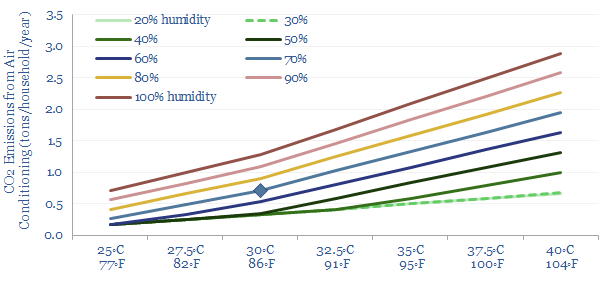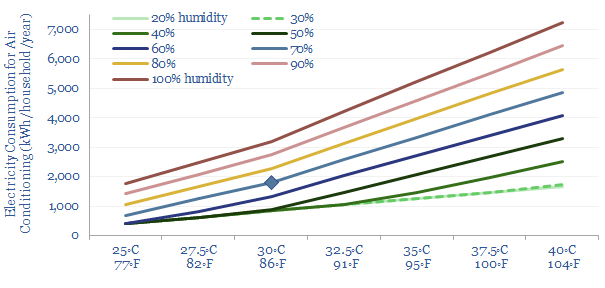The average US home uses 2,000 kWh of electricity for air conditioners each year. Air conditioning energy consumption is broken down from first principles in this data-file, as a function of temperatures, humidity, heating days, household size, insulation and coefficient of performance (COP). What routes to lower the AC energy demand and CO2 emissions?
The average US home uses 2,000 kWh/year of electricity for air conditioning, which is c17% of total household electricity consumption. Overall, the US uses c400 TWH pa of electricity for air conditioning, which is 10% of the US’s total electricity consumption, and 20% of total global energy demand for air conditioning (note here).
This data-file aims to break down the air conditioning energy consumption from first principles, using simple maths and physics.
Our base case of 2,000 kWh per household per year reflects a 200 m2 home, in a climate with 30◦C (85◦F) average summer temperatures and 70% average summer humidity, that targets an internal temperature of 20◦C, which is achieved by running its AC unit(s) for c30% of the time, with an effective COP of 2.5x, and c25% of its “coldness” leaking back to the external environment every hour, through windows, walls, thermal bridges and opening/closing doors.
Depending on the CO2 intensity of the power grid, this will result in 0.75 tons of CO2 per household per year (chart below).

Humidity is a surprisingly large contributor to the total energy costs. About one-third of the total energy requirements from air conditioning are expended cooling air (specific heat capacity) and two-thirds are expended condensing water vapor (water will naturally drop out of the air when temperatures cool, latent heat capacity).
As a simple mental model, you can imagine that the electricity demand for air conditioning will vary linearly with cooling degree days ([ambient temperature minus target temperature] x percent of the year where cooling occurs x 365), humidity, house size, AC COP, coldness leakage rate.
The most realistic opportunities to improve air conditioning energy performance are through higher COPs, improved home insulation, and smart controls to optimize cooling.
Efficiency gains are particularly helpful to smooth out increasingly volatile grids (best note here), which will inherently tend to become strained during hellishly hot conditions.
Next-generation technologies may also improve the energy intensity of air conditioning by adsorbing water onto sorbents (see AirJoule). There are also opportunities to lower the CO2 intensity of the power grid, by ramping solar, wind, hydro, nuclear.
Please download the data-file to explore the air conditioning energy consumption. You can benchmark the electricity demand for your location by varying the property size (in m2), average summer temperature (in C or F) and average humidity (in %).

